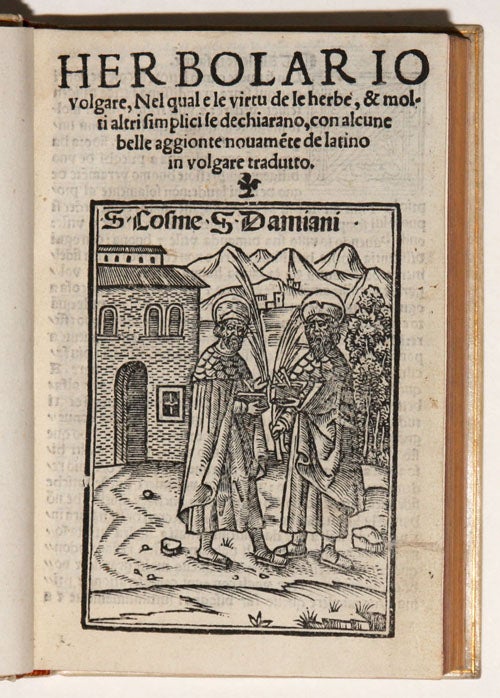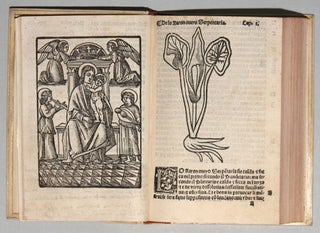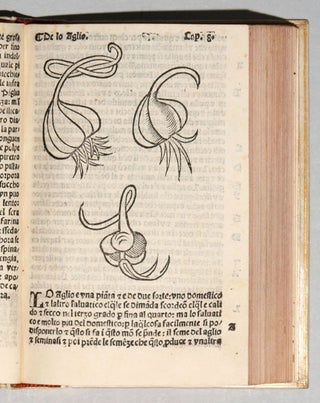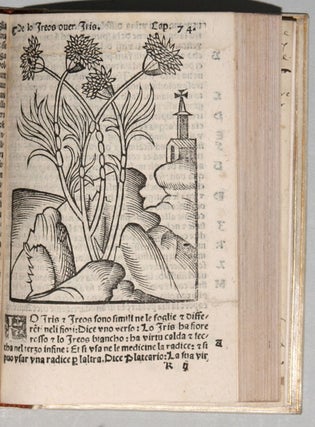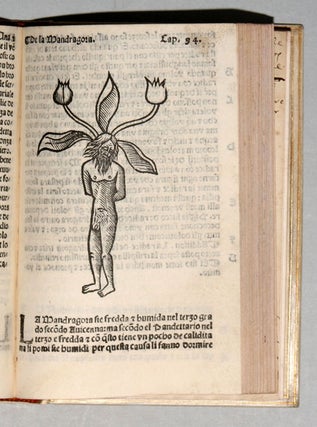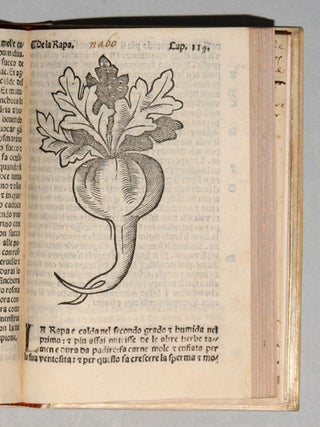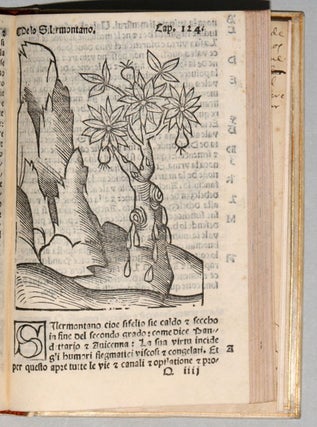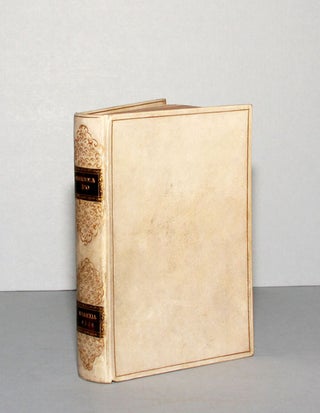Herbolario Volgare, nel qual e le virtu de le herbe, & molti altri simplici se dechiarano.
8vo. 8vo. [14.4 x 9.6 cm], (180) ff., with 151 large woodcut illustrations of which 149 are of plants. Bound (somewhat tightly) in later vellum over boards, covers gilt-ruled, spine gilt with morocco title pieces, a.e.g. Some marginalia cropped at time of re-binding as well as 2 pages of manuscript annotations in Portuguese. Minor tear repaired at edge of title, just touching woodcut border; some minor soiling, but generally a fresh copy with dark strikes of the woodcuts. Rare, second Italian-language edition (first 1522) of the Herbarius latinus, important for the dissemination of botanical/medical knowledge in popular culture and particularly for the adoption of this originally German-printed Latin work for readers in the Veneto. The second section, with 96 chapters, includes information on laxatives, aromatics, fruits, seeds, gums and resins, salts, minerals goose-grease, cheese, honey, ivory, and much more. Anderson notes that this section probably contributed to the book’s success: “It was concerned with the materials of medicine that were commonly available in the shops of apothecaries and spice merchants. Through the use of the Herbarius the average man could easily find what drugs to use and purchase them in most towns.” According to Anderson, “the Herbarius sold as well in Italy, if not better. There its second section may have contributed to its success, for it was concerned with the materials of medicine that were commonly available in the shops of apothecaries and spice merchants. Through the use of the Herbarius the average man could easily find what drugs to use and purchase them in most towns. The second section has 96 chapters, though many of them are very brief. They deal with the following: laxatives; aromatics; fruits, seeds, and plants of garden and orchard; gums and resins; salts; minerals and stones; and a variety of animals and their products, such as goose-grease, cheese, honey, and ivory” (Anderson, Illustrated History of the Herbal, pp. 86-7).. The last chapter (CLI) de Vino e Aceto is illustrated with a woodcut showing wine barels in a cellar. According to Hunt, the woodcut on the title-page showing Saints Cosmos and Damian appears here for the first time. Our copy has 2 full page and numerious marginal early 17th c. annotations in Portuguese, mentioning Brazil in one case and giving the date of 1630 in another. There are two mentions of experiments in planting and cultivating cotton and ginger, "brought from Brazil"--one of them dated 1643 (f. aa6 r and f. Y6 r). In 1577, the Portuguese prohibited the cultivation of ginger in Bahia due to their interests in the India trade. However, Bahian colonists ignored the law and continued to grow it, selling it in secret to the Dutch and the English, among others. The use of lead for treating bladder ulcers is also discussed (f. Y6 r). Most curious is a recipe for avoiding and curing hemorroids by "Father Manoel da Anunciação, Capuchino, in the year 1630." The recipe involves frying small frogs in oil (without salt) "until the oil stops making noise... Once they are fried, take them out of the oil and put the oil in a bottle and apply this liquid with your fingers on the bone and on the hemmorhoids and they will heal quickly" (f. Y6 v). *Hunt I.34; Mortimer I.228 (1520 Latin); Anderson, Illustrated History of the Herbal, pp. 86-7; Schwartz, Sovereignty and Society in Colonial Brazil, esp. pp. 158-9.
* Hunt 34; Mortimer I.228 (1520 Latin).
Price: $11,850.00

